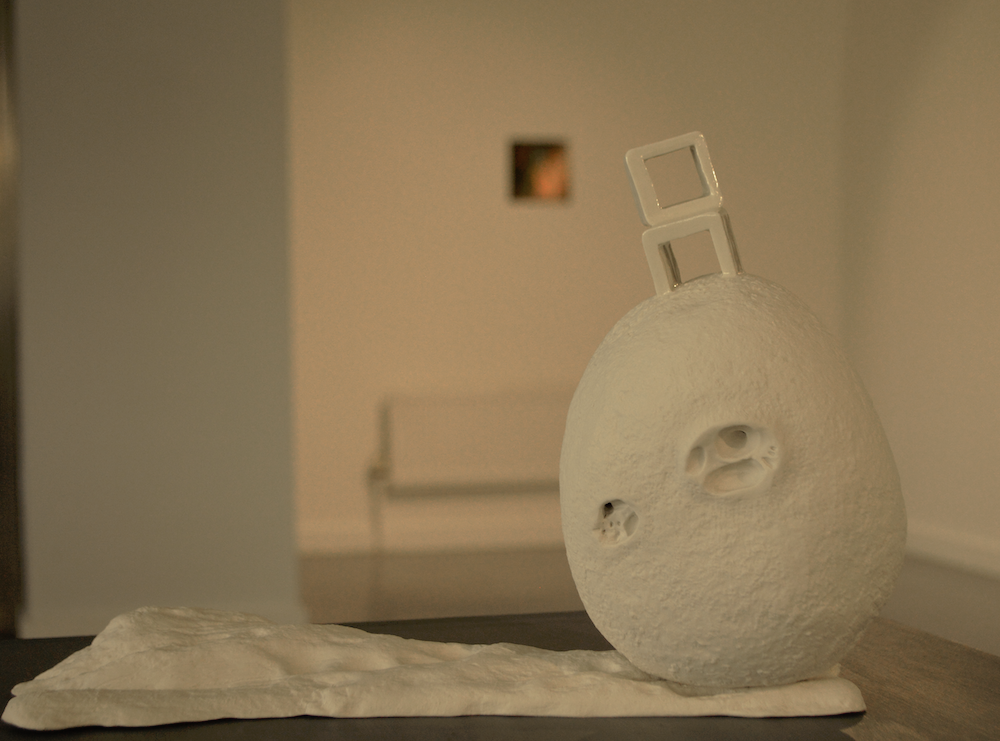Title
Sinterella
Year
2021
Category
Curator

A group exhibition at glór, Ennis
Sintering is the process of fusing powder-based materials into a solid state through a reaction to high temperature. In clay work, sintering is when particles stick together permanently, and the work is considered fully fired.
Sinterella is a group exhibition produced to explore the idea of telling stories through material. Each artist chooses her material as a method to express a narrative. The process of the works’ creation is often regarded as phases or drafts for a finished piece, but in Sinterella, we look at the creative process as a paragraph that lives on as an integral part of the entire story.
Cashman and McKee’s projects respond to useful household objects and use the clay to explore the pebbles to tell different stories, perhaps less utilitarian, about our life and our history. By taking the objects out of their original contexts, both artists offer brand new narratives for us to think about when seeing a chair, or a spoon. It is an opportunity to reconsider the potential in everything that surrounds us.
Yalcinkaya uses plaster, a material “cousin” of clay, to connect a Kurdish mythological narrative to her life in Ireland. The piece will progress throughout the exhibition period to offer engagement with the artist’s writing about the visual artwork, and her journey to Ireland, including a consideration of the chosen materials.
Participating artists:
Martha Cashman, Annita McKee and Insaf Yalcinkaya
Martha Cashman is a Cork-based artist who works
primarily in paper porcelain. She traps seeds on the surface of
the clay to create surface decoration and adds driftwood. She
mainly works with thin pieces of clay to build her sculptural
work, which is high fired to 1280 degrees thus giving the pureness
to the porcelain that allows the light to shine through the
pieces, this brings the clay back to life again.
Her Tool collection began as a dedication to the elders in her
life. The porcelain pieces respond to the symbolism and cultural
significance behind the spoon that is a tool for nourishment and
is also often used as a power tool held in the drawer in the
kitchen, or a threat if one steps out of line. Recurring memories
of her Grandmother and her role in the home resonate deeply with
the artist’s practice. She began sculpting a series of porcelain
spoons based on memory and narrative on the play between beauty
and trauma, realism, and abstraction.
Annita McKee creates slip cast ceramic
sculptures inspired by her experience diving and exploring the
ocean and its shores. Her pieces are often hand-built chairs and
slip casts of found pebbles that are selected according to their
physical properties and emotional response they may bring. These
sculptures suggest the trace of people on an emotional journey.
The artist takes her sculptures underwater to photograph. It is
here, away from outside realities that psychological scenarios are
considered. Sometimes a physical separation, a removal from any
given situation is necessary to see clearer, to feel more or less.
The emoting chair forces us to stop and think – considering a
mental state. Chairs beneath the ocean’s surface promote freedom
to explore feelings whilst the inhabitants interact.
The artist considers the physical qualities of pure white
porcelain as a representation of human beings’ fragility,
providing a blank canvas for individuals to form opinions and
responses in their own world.
Insaf Yalcinkaya is a Kurdish poet born in
Dersim in the Turkish part of Kurdistan. After a Bachelor degree
she taught in Primary and Secondary schools. She was a political
activist, and also a Political Consultancy Advisor and has
recognised refugee status in Ireland. She has also shown ceramics
in several art exhibitions. Insaf’s articles have been published
in national and local magazines and newspapers in Turkey, and her
poetry published in Correspondences: an anthology by Stinging Fly,
the MASI Journal and in Flare 14 and Flare 15 by Dublin’s
Sunflowers Session
This painting – entitled Shamaran – is made from wood, pinecones
and plasterwork. Shahmaran comes from Kurdish words “Shah”, which
means wise leader, and “Mar” which means snake. This is a legend
of the Kurds, which comes from Mesopotamia. The story of Shahmaran
is told the most in Mardin city in the south-east Anatolian region
of Turkey. A lot of souvenirs and portraits are made in Mardin and
are related to this mother Goddess of the Kurds. In prehistory,
Shahmaran lived in a heaven in the sky then she was obliged to
move underground due to the people’s betrayal, where she founded a
new heaven. She knows all the secrets of the universe about the
past and the future.
Engagements
The exhibition was accompanied by a series of free workshops for children and young people facilitated by Vicky Smith and Nathalie El Baba.